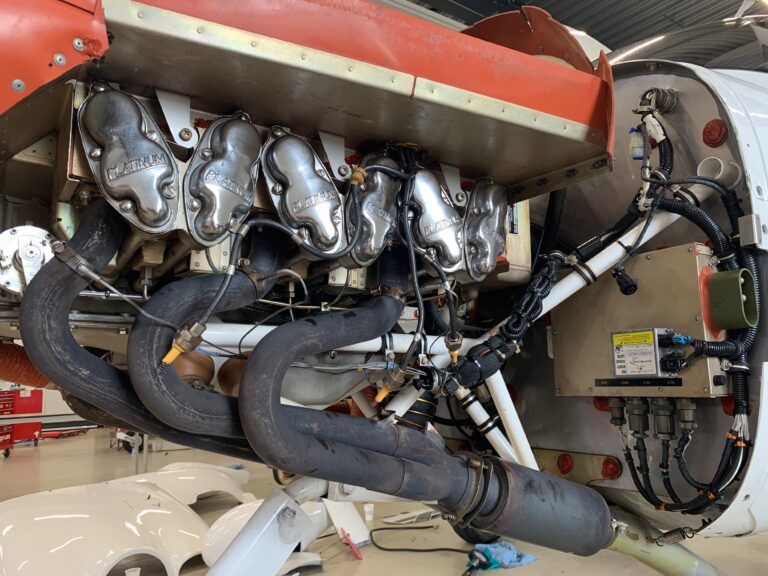In general the TCM IO-550N is a smooth and reliable engine.
The IO-550N is part of the same engine family tree that starts with the O-470 series.
Here’s the lineage:
- O-470 (1940s)
- Six-cylinder, air-cooled, horizontally opposed piston engine.
- Around 470 cubic inches displacement.
- Found in early Cessna 180/182/185 and Beechcraft Bonanza models.
- Set the basic crankcase, cylinder layout, and architecture for later engines.
- IO-520 (mid-1960s)
- “I” for fuel-injected, “O” for opposed.
- Based heavily on the O-470 design but bored/stroked to 520 cu in.
- Beefed-up crankcase, improved cooling, higher compression options.
- Widely used in Bonanzas, Barons, and Cessna 210s.
- IO-550 (late-1980s)
- Developed directly from the IO-520.
- Increased displacement to 552 cu in via a longer stroke.
- Improved crankcase strength, revised oil system, and higher continuous power capability.
- The “N” model in your SR22 is a specific variant with tuned induction and baffling optimized for that airframe.
So the IO-550N is essentially a “third-generation” development of the O-470, through the IO-520, with incremental refinements in displacement, cooling, strength, and fuel/induction systems. In the Cirrus SR22 – from G1 to G7 – the IO550N produces an impressive 310 hp at 2700 rpm, which gives the plane impressive performance and good fuel efficiency in the slick SR22 airframe.
When you buy a used SR22, these are the main points that should be checked about the engine (also see my other general checklist for SR22 buyers).
1. Compression is not everything with a big bore Continental engine. Until today man mechanics servicing big bore Conti engines are fixated on compression values alone. The truth is that many absolutely healthy 550s can have compression as low as 50/70 on one or more cylinders. Even TCM acknowledges today that these numbers (as long as they are not much lower and especially not lower than the “Master Orifice” value – say little about the engine’s health. An experienced Cirrus mechanic will never “pull” a cylinder based on a low compression value alone.
2. To get an idea about the real health of the engine, you have to borescope the cylinders with suitable equipment. You will mostly check for corrosion of the cylinder walls (a little on top you will find in many engines, but that is ok) and for burned exhaust valves which you will easily recognize by their greenish color. You can find photo charts with valve condition on the net.
3. Let the owner show you the latest oil analysis report (for example from “Blackstone”) which should be done at every annual. The report will tell a lot about the condition of the engine.
4. Hopefully the owner did the 25-hour oil changes most pilots in the COPA community prefer. Oil is cheap, and engines are terribly expensive. I use W100 oil only – and I add Camguard. The one oil type that’s not perfect for this engine is the 15W50 multigrade oil. Check Mike Busch’s articles on engine oil!
5. If at all possible let the owner show you the latest engine data downloaded from the MFD. Many owners have accounts at “Flightdata.com” or FlySto.net (better!). This way all you need is a link to the account to check the data. You can check all engine data, performance, electrical data. What I look at first is the CHTs, Cylinder Head Temperatures. It is a rule that most experienced Cirrus pilots follow: Never let CHT go over 380 degrees F. The Continental limit is 420 F, but it has been proven that the lower 380 F limit is much better for longevity.
6. Check the takeoff, full power , full rich Fuel Flow. It should be set up to at least 29 gph
7. Take a flashlight and look into the exhaust pipes. Are the “flame cones” in the center and symmetrical? If they are warped the muffler has to be overhauled or changed (I overhaul them). The left side is a simple muffler, the right side is a combined muffler and heat exchanger.
8. Check the electric boost pump for operation. You use it for starting the engine with “prime” and for takeoff/landing and switching tanks in the boost position.
9. When you start the engine the starter adapter should not slip! In many planes the prop hesitates a bit before the prop starts turning, and if it is very little, that’s probably ok. But more than a little means that the starter adapter might have to be changed or overhauled.
10. A good IO550N (and the smaller IO360 aswell) runs very smoothly (a 540 Lycoming feels very rough in comparison). There should be little vibration. If there is more vibration it could be coming from the prop – which should be dynamically balanced. Ask if that was done!
Of course there’s many other components that can be damaged. This is only a small list of typical items.
Most of this list is valid for the SR20’s IO-360 aswell. About the newer SR20’s Lycoming four cylinder IO-360 engine I don’t know much!

